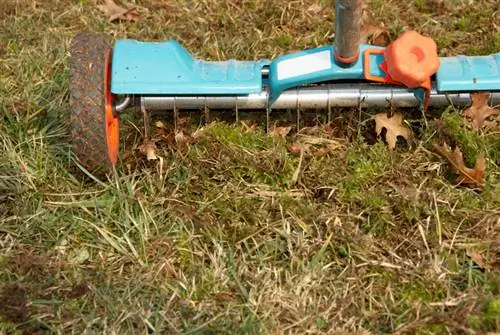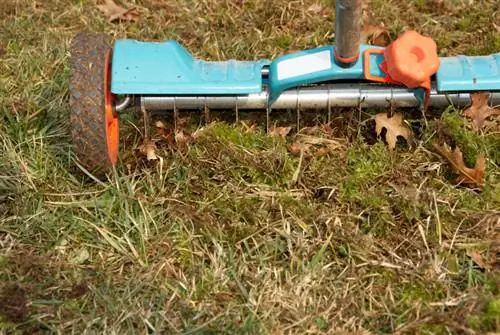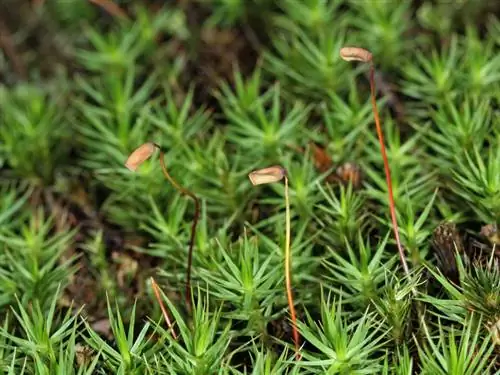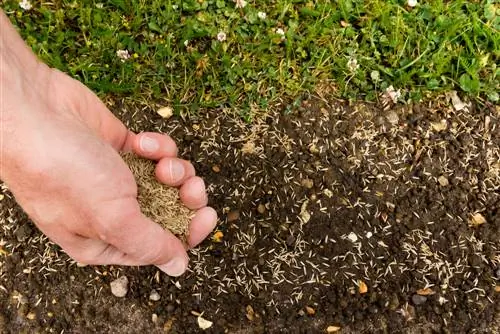- Author admin [email protected].
- Public 2023-12-16 16:46.
- Last modified 2025-06-01 06:02.
Moss specifically looks for shady, cool and lean locations on pavements, walls and in the garden that are avoided by ornamental and useful plants. The green pest spreads mercilessly in the lawn when the noble grasses are weakened. It is therefore hardly surprising that moss infestations are often unpleasantly noticeable. Find out what to do now.

How do I effectively remove moss in the garden?
To effectively combat moss in the garden, remove it from slabs and walls with a wire brush, vinegar or soda. In the lawn you should scarify, reseed, fertilize and ensure a cutting height of 4-5 cm. However, moss can be decorative in the bed and can be used as a moss garden.
How to keep slabs and walls free of moss
In the early infestation stage, you can remove moss from paving and walls using muscle power or home remedies. The following procedures have proven to be excellent in home gardens:
- Remove moss with a wire brush or a grout scraper
- Spray uncolored stone surfaces with apple or wine vinegar (not vinegar essence)
- Treat mossy plaster with a solution of 20 g soda and 10 l boiling water
If thick moss pads have already formed, fighting it with home remedies will be futile. In this case, specialist retailers have environmentally friendly moss killers available. Products such as Compo Bio-Moss-Free or Celaflor Naturen Moss-Free combat the green coating with biodegradable ingredients.
Removing moss from the lawn - How to do it
If moss gains the upper hand in the lawn, the noble grasses are weakened by unsuitable conditions. Don't use toxic iron fertilizer now, because the corrosive product only has a temporary effect. It's better if you help the troubled lawn with the following measures:
- Mowing, scarifying and aerating the mossy lawn
- Sprinkle the combed out green area with lawn reseeding
- Spread a thin layer of sand over the reseeding and water
- Additional lime to lawn areas with a pH value below 5.5
Provide the aerated and reseeded lawn regularly with a nitrogen-rich fertilizer in spring and summer. In autumn, strengthen the turf with Patentkali against frost and snow. Do not mow your lawn shorter than 4-5 cm. At this height, the noble grasses shade the moss so that it cannot establish itself.
Make a virtue out of necessity in the bed - this is how it works
Where moss spreads in the bed, ornamental plants can rarely be cultivated. Instead of destroying the moss under trees and similarly shady locations, simply consider peaceful coexistence. Japanese moss gardens show how decorative a well-kept moss carpet can be.
Collect or purchase tried and tested garden moss species, such as wider clay moss (Polytrichum commune), broom moss (Dicranum scoparium) or fountain liver moss (Marchantia polymorpha). Plant the moss on a 5 cm thick base of leaf compost or peat in a humid, shady location. Until a dense moss cover has developed, regularly shower the area with collected rainwater.
Tip
When taking all control measures, please remember that moss plays an important role in the ecosystem and that numerous species of moss, including peat mosses, are threatened with extinction. Since moss on damp slabs poses a risk of accidents and suffocates the grass in lawns, combating it is understandable and sensible. However, if moss thrives on the tree, the land plant acts as a food plant for insects, provides nesting material for birds and serves as a retreat for beneficial insects.






